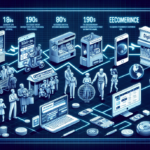Introduction to Ecommerce: Transforming Global Retail
Ecommerce, or electronic commerce, has evolved dramatically since its inception in the 1960s. Today, it represents a substantial portion of global retail sales, with global ecommerce sales projected to reach $5.7 trillion by 2025 (eMarketer), fundamentally changing how consumers shop and businesses operate. This article delves into the comprehensive history of ecommerce, tracing its development from early electronic data exchanges to the sophisticated online marketplaces of today. Join us as we explore the pivotal events and innovations that have shaped the ecommerce landscape.
Early Beginnings: The Emergence of Ecommerce in the 1960s
The origins of ecommerce can be traced back to the 1960s with the development of Electronic Data Interchange (EDI) systems. These systems enabled businesses to exchange documents such as invoices and purchase orders electronically, replacing traditional paper-based methods. Although rudimentary, EDI laid the foundation for future online transactions by streamlining business communications and reducing operational costs.
In the subsequent decades, the 1970s and 1980s, the introduction of Electronic Funds Transfer (EFT) systems further advanced ecommerce. EFT allowed for the secure and efficient transfer of funds between businesses and banks, paving the way for automated payment processes essential for online commerce.
With the advent of the internet in the 1990s, ecommerce entered a new era. Pioneering online marketplaces like Amazon and eBay launched, offering consumers unprecedented access to a wide range of products globally. This period marked the beginning of ecommerce as a mainstream retail channel.
The Rise of Online Shopping: A Look at the 1990s and Early 2000s
The early 1990s witnessed the birth of the World Wide Web, revolutionizing ecommerce by enabling businesses to create online storefronts. Amazon.com, launched in 1995 as an online bookstore, quickly expanded its product offerings, setting new standards for online retail. Similarly, eBay, founded in 1995, introduced the concept of online auctions, providing a platform for consumers to buy and sell goods directly.
The convenience of online shopping—allowing consumers to purchase products from the comfort of their homes—led to exponential growth in ecommerce sales. By the early 2000s, ecommerce had become a significant component of the retail industry, with sales reaching billions of dollars annually.
The proliferation of mobile devices and the emergence of social media in the mid-2000s further accelerated ecommerce growth. Consumers could now shop anytime and anywhere, driving the development of responsive websites and mobile apps optimized for shopping on the go.
The Impact of Amazon on the Ecommerce Industry
Amazon.com, founded by Jeff Bezos in 1994, has been a driving force in shaping the ecommerce industry. Starting as an online bookstore, Amazon rapidly diversified its product range, introducing categories like electronics, apparel, and cloud computing services through Amazon Web Services (AWS).
Amazon's customer-centric approach, emphasis on fast and reliable shipping, and continuous innovation have set industry benchmarks. Features such as Amazon Prime offer members benefits like free two-day shipping and exclusive access to streaming services, enhancing customer loyalty and driving repeat business.
Furthermore, Amazon's marketplace model has enabled millions of third-party sellers to reach a global audience, fostering entrepreneurship and expanding the variety of products available to consumers. This ecosystem has spurred the creation of other ecommerce platforms like Shopify and BigCommerce, empowering small and medium-sized businesses to establish their online presence.
The Role of Social Media in Ecommerce: How Instagram and Facebook Changed the Game
In recent years, social media platforms such as Instagram and Facebook have become integral to the ecommerce strategy of many businesses. These platforms offer features like shoppable posts and integrated storefronts, allowing businesses to sell products directly through their social media accounts.
One significant advantage of leveraging social media for ecommerce is the ability to reach a vast and diverse audience. With billions of active users, platforms like Instagram and Facebook provide businesses with unparalleled opportunities to showcase their products to potential customers worldwide.
Moreover, social media platforms offer robust analytics tools that provide insights into customer behavior and preferences. By analyzing metrics such as engagement rates, click-through rates, and conversion rates, businesses can refine their marketing strategies and tailor their offerings to better meet consumer demands.
Additionally, social media facilitates direct interaction between businesses and customers. Engaging with customers through comments, direct messages, and live events fosters a sense of community and builds brand loyalty.
The Evolution of Payment Methods in Ecommerce
As ecommerce has matured, the variety of payment methods available to consumers has expanded significantly. Initially dominated by credit and debit card transactions, the landscape now includes digital wallets, mobile payments, cryptocurrency, and Buy Now, Pay Later (BNPL) services.
PayPal remains one of the most popular payment gateways, offering secure transactions without the need to share credit card details directly with merchants. According to Statista, PayPal has over 426 million active user accounts as of 2023, highlighting its widespread adoption.
Mobile payment solutions like Apple Pay and Google Pay provide seamless and secure payment experiences, particularly on mobile devices. These technologies leverage biometric authentication and tokenization to enhance security and user convenience.
Cryptocurrencies, such as Bitcoin and Ethereum, have also entered the ecommerce space, offering an alternative form of payment that emphasizes decentralization and security. While still niche, the acceptance of cryptocurrencies is growing as more businesses recognize their potential.
BNPL services, such as Klarna and Afterpay, have gained popularity by allowing consumers to split purchases into interest-free installments. This flexibility appeals especially to younger demographics and those seeking budgeting options.
Mobile Commerce: How Smartphones Changed the Way We Shop Online
The proliferation of smartphones has revolutionized the ecommerce landscape, giving rise to mobile commerce (m-commerce). M-commerce now accounts for a significant portion of total ecommerce transactions, with projections indicating that it will continue to grow as mobile device usage increases globally.
The convenience of shopping via mobile devices has led businesses to prioritize mobile-optimized websites and dedicated apps. Responsive design ensures that online stores provide a seamless user experience across various screen sizes, enhancing accessibility and user engagement.
Personalization is a key advantage of m-commerce. Utilizing data analytics and machine learning, ecommerce platforms can offer personalized recommendations, targeted promotions, and tailored content based on individual user behavior and preferences. This personalized approach not only improves the shopping experience but also boosts conversion rates.
However, m-commerce also presents challenges, particularly in the realm of security. Ensuring the protection of user data and securing transactions on mobile devices is paramount. Ecommerce businesses must implement robust security measures, such as encryption and multi-factor authentication, to safeguard against cyber threats and maintain consumer trust.
Ecommerce and Globalization: Breaking Down Borders
Ecommerce has been a driving force behind the globalization of retail, enabling businesses to reach customers beyond their domestic markets with relative ease. The ability to set up online storefronts means that businesses can operate internationally without the need for physical presence in each market.
Platforms like AliExpress and Shopify facilitate cross-border trade by providing tools for international shipping, currency conversion, and localized marketing. This has opened up new revenue streams for businesses and increased product diversity for consumers worldwide.
Moreover, ecommerce has reduced the barriers to entry for small and medium-sized enterprises (SMEs) looking to expand globally. With access to a global customer base, SMEs can scale their operations and compete with larger corporations on an international level.
Additionally, ecommerce promotes cultural exchange by making products from different regions accessible to a global audience. Consumers can discover and purchase unique items from around the world, fostering appreciation for diverse cultures and supporting artisanal and niche markets.
The Future of Ecommerce: Predictions and Trends for the 2020s
Looking ahead, the ecommerce industry is poised for continued innovation and growth. Key trends shaping the future of ecommerce include:
- Augmented Reality (AR) and Virtual Reality (VR): These technologies will enhance the online shopping experience by allowing consumers to visualize products in their own environment before making a purchase. For instance, AR can enable users to see how furniture fits in their home, while VR can offer immersive virtual storefronts.
- Artificial Intelligence (AI) and Machine Learning: AI-driven tools will further personalize the shopping experience through advanced recommendation engines, chatbots, and predictive analytics. These technologies will help businesses better understand and anticipate consumer needs.
- Voice Commerce: With the rise of voice-activated devices like Amazon Echo and Google Home, voice commerce is set to become a more prominent method of shopping. Consumers will increasingly use voice commands to search for products, place orders, and receive personalized recommendations.
- Omnichannel Integration: Seamless integration between online and offline channels will continue to be essential. Businesses will focus on providing a unified customer experience across websites, mobile apps, physical stores, and social media platforms.
- Sustainability: As consumer awareness of environmental issues grows, ecommerce businesses will be pressured to adopt sustainable practices. This includes using eco-friendly packaging, optimizing supply chains to reduce carbon emissions, and offering sustainable products.
One of the major challenges for ecommerce businesses in the 2020s will be balancing innovation with sustainability. As consumers demand more environmentally responsible practices, businesses must innovate in ways that also support sustainability goals.
Influencers and Affiliate Marketing in Ecommerce
The rise of influencer marketing and affiliate marketing has significantly impacted ecommerce strategies. Influencers, who have established credibility and large followings on platforms like Instagram and YouTube, can drive substantial traffic and sales by promoting products to their audiences.
Affiliate marketing complements this by enabling businesses to partner with bloggers and online publishers who earn commissions for driving sales through their referral links. This performance-based model ensures that businesses only pay for actual sales generated, making it a cost-effective marketing strategy.
According to a Statista report, global affiliate marketing spending is expected to exceed $8 billion by 2022, highlighting its growing importance in the ecommerce ecosystem. These marketing techniques not only enhance brand visibility but also build trust and credibility through authentic endorsements and recommendations.
Navigating Legal Challenges in Ecommerce: Taxation, Data Privacy, and More
Ecommerce operates within a complex legal landscape that businesses must navigate carefully. Key legal challenges include:
- Taxation: Ecommerce businesses must comply with varying tax regulations across different jurisdictions. This includes understanding sales tax requirements, value-added tax (VAT), and import duties, which can be particularly challenging for businesses operating internationally.
- Data Privacy: With the increasing collection and storage of customer data, ecommerce businesses must adhere to data privacy laws such as the General Data Protection Regulation (GDPR) in the European Union and the California Consumer Privacy Act (CCPA) in the United States. Ensuring data security and transparent data handling practices is essential to maintain consumer trust and avoid legal penalties.
- Intellectual Property: Protecting intellectual property rights is crucial for ecommerce businesses to prevent the unauthorized use of their trademarks, copyrights, and patents. This includes safeguarding product designs, branding, and proprietary technologies.
- Consumer Protection: Ecommerce businesses must ensure fair trading practices, including transparent pricing, accurate product descriptions, and reliable customer service. Adhering to consumer protection laws helps prevent disputes and builds a trustworthy brand reputation.
Staying informed about and compliant with these legal requirements is vital for the sustainable growth and success of ecommerce businesses in a global marketplace.
Sustainability in Ecommerce: How Eco-Friendly Practices are Changing the Industry
As environmental concerns become increasingly prominent, sustainability has emerged as a critical focus area for ecommerce businesses. Consumers are more conscious of the environmental impact of their purchases, leading to a demand for eco-friendly products and sustainable business practices.
Key sustainability initiatives in ecommerce include:
- Eco-Friendly Packaging: Many businesses are adopting biodegradable, recyclable, or reusable packaging materials to minimize waste and reduce their carbon footprint.
- Carbon Neutral Shipping: Companies are investing in carbon offset programs and optimizing their logistics to reduce greenhouse gas emissions associated with shipping and delivery.
- Supply Chain Sustainability: Ensuring that suppliers adhere to sustainable practices is essential. This includes sourcing materials responsibly, reducing energy consumption, and minimizing waste throughout the supply chain.
- Product Sustainability: Offering products that are durable, repairable, and made from sustainable materials caters to the growing consumer preference for environmentally responsible products.
Adopting sustainable practices not only addresses environmental concerns but also enhances brand reputation and meets the expectations of eco-conscious consumers. According to a Nielsen report, 73% of global consumers say they would change their consumption habits to reduce their environmental impact, highlighting the importance of sustainability in ecommerce strategies.
Ultimately, the integration of sustainability into ecommerce operations is essential for long-term success and contributes to the broader goal of protecting our planet for future generations.
Conclusion: The Dynamic Evolution of Ecommerce
The history of ecommerce is marked by rapid innovation and continuous transformation. From the early days of electronic data interchange in the 1960s to the sophisticated, AI-driven platforms of today, ecommerce has fundamentally altered the way we shop and conduct business. As technology advances and consumer preferences evolve, ecommerce will continue to adapt, offering new opportunities and challenges for businesses worldwide.
By embracing emerging trends such as mobile commerce, social media integration, and sustainable practices, ecommerce businesses can stay competitive and meet the ever-changing demands of the global marketplace. The future of ecommerce promises exciting developments that will further enhance the shopping experience and drive the growth of the global economy.




















